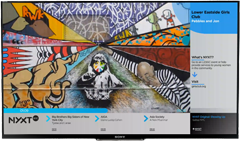Founded in 1857, The American Institute of Architects consistently works to create more valuable, healthy, secure, and sustainable buildings, neighborhoods, and communities. In this edition of Press Play, we talked with Joel Mills and Erin Simmons, directors of AIA’s Center for Communities by Design.
NYXT: What is AIA’s Center for Communities by Design?
Joel Mills: AIA’s Center for Communities by Design serves as a catalyst, convener, and resource center that helps AIA members and partners work with citizens and other stakeholders to envision and create more sustainable, healthy, safe and livable communities. Our programs have a half-century tradition of producing some of America’s most celebrated communities, ranging from the Pearl District in Portland, Oregon to the Santa Fe Railyard Redevelopment to East Nashville, Tennessee.
NYXT: How does your personal vision resonate with AIA's mission?
JM: The AIA’s mission is to be a resource to architects in service to society. Through our Design Assistance Team programs, we bring architects and other professionals together with civic leaders and citizens to identify principal community values and express them in strategies that represent those values in an enduring and meaningful way. Our program founders believed that the story of American urbanism was rooted in democratic ideals and the American Dream. We believe that we cannot build our cities from the top-down - we must build them from the ground up.
NYXT: What are AIA's main goals for this year?
JM: One of our big goals this year is to use our work to demonstrate the power of democratic design in addressing our most urgent challenges in communities. We’ve seen a growing retrenchment in top-down approaches to city-building and trickle-down urbanism during the past decade. Our hope is to leverage the results of our work to demonstrate the value of democratic approaches that lead to sustainable and enduring urban places. With global population growth accelerating, the urgency of our work has never been greater.
NYXT: What is the most challenging aspect of your job?
JM: Context is an important aspect of our work so the challenges are always a bit different depending on the community we are working with. This year, we will work with communities that are as small as 1.29 square miles (Central Falls, RI) and mega-cities like Rio de Janeiro. The key challenge in our work is in designing processes that empower citizens to take action together on common interests which build momentum for change over time. Our process is designed to leverage the most powerful organizing principle in city-building: democracy.
NYXT: What are your views of how NYC is evolving? Have your programs ever worked within the city?
JM: We’ve worked in New York City a couple of times in the past. We were in Staten Island in 2008, and after Superstorm Sandy we held a process that focused on a portion of the Rockaways in Queens. New York is an interesting city and you can always find examples of work that is encouraging as well as issues that give you concern. One of the most encouraging developments we’ve seen recently is DemocracyNYC. If that initiative is successful it will unlock untold resources and drive collective work to address key urban challenges the city faces.
Click to read the Rockaways R/UDAT report
NYXT: How do you think architecture can make a difference towards the challenges of the 21st Century?
JM: Many of this century’s most important challenges, from climate change to affordable housing, require the skills of architects to solve. Architecture is not only about building design but includes the urban design of our cities. In addition, we need to involve the public directly in solutions to our most pressing problems and architects are well-positioned to facilitate community-driven strategies that empower citizens as change agents.
AIA team members gather ideas from residents of the Rockaways following Superstorm Sandy, 2013.
The Rockaways R/UDAT team discusses potential revitalization strategies, 2013.
If you want to read more interviews about NYXT’s video content partners, check out Press Play: Planned Parenthood Direct and Press Play: Union Settlement.
Subscribe to the NYXT newsletter
Learn about upcoming events, volunteer opportunities, and new organizations looking for your help.


